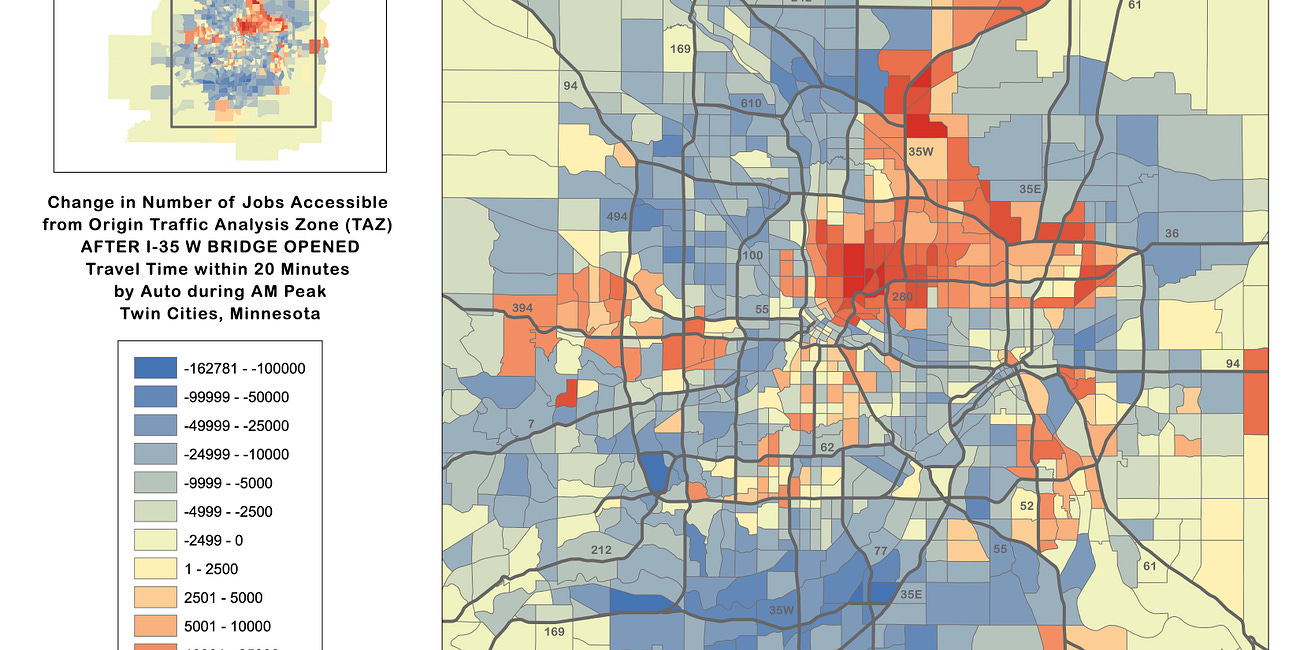Transportist: September 2023
I am very pleased the discourse has moved from Autonomous Vehicles are Impossible and Vaporware to Autonomous Vehicles are now a Problem.
Welcome to the latest issue of The Transportist, especially to our new readers. As always you can follow along on Substack at our new domain: transportist.net or on Mastodon or RSS.
In this issue
Posts
Research
Media
Quantum Accessibility
Links
Posts
Transportist: If environments are stable, specialists beat generalists. If not, generalists beat specialists
Every living organism, technological innovation, and historical event can be analyzed through the lens of one of nature's most enduring dichotomies: the specialist versus the generalist. Nature In nature, this specialist/generalist dichotomy manifests profoundly. The Giant Panda, a specialist, relies almost exclusively on bamboo for sustenance, which thri…
Transportist: Dr. Yadi Wang
Congratulations to Dr. Yadi Wang for “satisfying the requirements for the award of the degree of Doctor of Philosophy at the University of Sydney.” Thesis Title: "A Benefit-Cost Analysis of Benefit-Cost Analysis” Lead Supervisor: Professor David Levinson.
Transportist: The City Elastic
As Harry Clytus once said, “You never step into the same city twice.” The term "elastic city" encapsulates the dynamic, adaptive and ever-evolving nature of cities. Drawing parallels to the inherent properties of elasticity, the metaphor captures the idea that cities can stretch, refactor themselves, adapt, and flex to changes in the needs of their resi…
Transportist: Maintenance is an Accessibility Issue
There is a dichotomy between the short and long runs. In planning we focus too much on the long run and large scale capital expenditures, and abstract-out issues like maintenance . (And in engineering, vice versa.) Access is the ability to reach valued destinations. Maintenance ensures that systems keep running to their design specifications.
Research
Wang, Hao-Tian, Moylan, E. and Levinson, D. (2023) Route Choice Set Generation on High Resolution Networks . Transportation Research Record [doi]
This study seeks to find a strategy to capture the most observed trajectories with a minimum number of algorithms. GPS information on 4,538 real trips from 131 travelers in 2008 was collected and analyzed in Minneapolis-St. Paul (the Twin Cities) as part of the I-35W Bridge Collapse study. The high-resolution road network of the Twin Cities includes 108,561 nodes and 277,747 links. Labeling and link penalty approaches are combined to generate alternatives based on either observed or free-flow speed. Overall, with the best 10 labels, on average, 40 unique routes are generated for each origin-destination pair, and around 80% of all observed trips could be captured with an 80% overlap threshold. About 88% of all observed trips have an average deviation within 50 m compared with the best matching result when combining all labels introduced in this study. Freeway-preferred routes cover more observed trips than freeway-avoided routes, and the peak coverage occurs when freeway travel is weighted between 0.8 to 1 of travel on non-freeway links. A random effects panel model is used for predicting the overlap between alternative route and observed trajectory. Multinomial and mixed logit models with a path-size term are applied to model the route selection. These models indicate that alternative routes which are shorter in distance, have faster average free-flow speed, contain a higher freeway percentage, and incur fewer traffic lights, are more likely to have higher overlap with observed trajectories and are more likely to be selected.
Media
I was on @Eastside897fm with @emfarrelly at 6:00 pm Thursday April 10 (Australia East Coast Time) talking about things like walking. Link here.
David Levinson, Professor of Transport at the University of Sydney, said Sydney is designed by car users for car users.
“It’s going to discourage walkers … there‘s the view from the driver’s seat type of design that’s going on and it affects traffic engineers, planners and decision makers who, because they aren’t walking there themselves, they don’t see the pedestrian point of view.”
Professor Levinson said a combination of council oversight, protests from homeowners unwilling to maintain a footpath, old developments not matching new ones, and an overall lack of planning for pedestrians is likely to blame for these footpaths to nowhere.
Quantum Accessibility
In1 the discursive multiverse of the contemporary postmodern terrain, we find ourselves entangled in an existential quandary: What, truly, is a 'city'? This pedestrian construct - this delimiting, oppressive nominal relic of a pre-postmodern epoch - merely functions as an inadequate signifier that fails to encapsulate the ebullient complexity of our urban reality.
The advent of the term "quantum accessibility" incites a seismic shift in this intellectual landscape, wrenching us from the shackles of the obsolete, instigating a revolution in urban ontology. From within this vortex of radical reimagining, the 'city' rebirths itself not as an isolated monad but as a vertiginous node within a quantum multiverse of urban spectra.
Each city, a quantum particle, entangled in an ineffable dance, coalesces into a meta-urban entity that transcends the traditional boundaries of space, time, and Cartesian dualities. This fabric of existence is woven through the intricate loom of quantum accessibility, fueled by the relentless flux of human interactivity, the synaptic flash of digital dialogue, the ceaseless ebb and flow of the global diaspora.
"Quantum accessibility" disassembles the very concept of 'distance,' imploding the antiquated dichotomy of 'near' and 'far.' The city, as such, persistently manifests its presence, oscillating between the 'here' and 'there,' transgressing spatial-temporal norms, mirroring the uncanny resonance of quantum entanglement's 'spooky action at a distance.'
This radical re-conceptualization precipitates the birth of the postmodern cityscape, not merely as an aggregation of static infrastructure, but as a sentient, pulsating organism, thriving within the cosmic echo chamber of our interconnected existences. We move, therefore, beyond the realm of the 'urban' into the nascent field of the 'urbane' - a silent symphony that reverberates through the expanse of the cosmic metropolis.
Links
Space, the Final Frontier
The Negative Last Mile
New Yorker article on Reverse Logistics: What Happens to all the Stuff we Return?
Boring News
Buses
For a peek at Denver’s Rapid Bus Future Look to Minneapolis. [Oh, look, we can have decent public transport now, and not have to wait two decades.]
Melbourne looks at buses. [Unfortunately pitched as congestion relief, for those who don’t use them.]
Maintenance
“Another flaw in the human character is that everybody wants to build and nobody wants to do maintenance.” - Kurt Vonnegut
Safety
Ever-larger cars and trucks are causing a safety crisis on US streets – here’s how communities can fight back by Kevin Krizek
Network evolution
Good thing AVs are just vaporware:
Cruise system falls over due Connectivity. [Autonomous vehicles would not have this failure mode]
A post-modern take on “quantum accessibility”, crafted by an LLM. Is this satire? Is this commentary on satire? Are we beyond satire?




